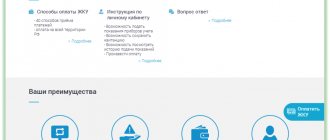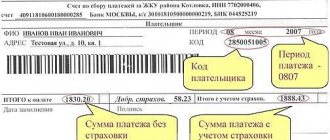The concept of housing and communal services
For a normal existence, a person, among other things, needs housing. It doesn’t matter whether it is a private house or an apartment in a high-rise building. Living in a particular place requires maintaining a house or apartment in a habitable condition that complies with legally established technical and sanitary and hygienic rules. And amenities in the form of hot or cold water, electricity and heating during the cold season are also a necessary factor for normal existence.
Such services provided to the population are called housing and communal services, because they provide several residential and other facilities at once, which is much more convenient than providing each specific building. Special organizations provide these services:
- Housing and communal partnerships (TKZH);
- Management companies (MC);
- Housing and communal services (HCS).
The concept of housing stock and residential premises is disclosed in Art. 15 of the Housing Code of the Russian Federation.
How can I receive documents by email?
You can receive receipts for housing and communal services for a house or apartment electronically in two ways:
- configure the function in Internet banking;
- visit the organization involved in these matters.
When paying through online services, after transferring funds, you must go to your personal account and follow the link, or open the “History” section. A receipt will be displayed in the window, and you can send it to your e-mail address. This method allows you to receive a payment document only after the obligation has been fulfilled. The advantage of contacting the Unified Settlement Center (UISC) is that payment papers will arrive before the last day of payment.
Types of utility payments
You have to pay for everything, including the provided housing and communal services. For the convenience of calculating payments, different statements are maintained depending on the type of service provided. Among the types of housing and communal services, the following are distinguished:
For each column from the above list, charges are made and transferred to the owner of the square meters in the form of a receipt indicating the total amount that must be paid on time. Typically, such receipts are delivered to the apartments of city residents by employees of special housing and communal services.
Situations vary
Conscientious people try to avoid debt, so as not to accumulate debts and not lose the opportunity to receive this or that service, so they pay all necessary bills at once. But there are situations in life when once again the receipt suddenly did not arrive.
This can happen for various reasons. For example, an employee of the management company did not deliver it, the receipt fell out and flew away, rolled behind the mailbox or ended up in a neighboring one. More complex situations may arise. For example, a person lives far from an apartment that he owns, and it is inconvenient for him to travel across the city or even to another locality to get a receipt. Or, for example, someone has several apartments located in several areas.
But whatever the reason, the question remains, what to do if you haven’t received a receipt? Should I take any action or wait for the next payment? Who should I contact and can I view it electronically?
In fact, if the payment does not arrive, or the receipt was delivered later than indicated, nothing bad has happened yet. Here are some recommendations on what to do in such cases:
- To obtain information about the lost document, you can contact the Housing and Communal Partnership Management Company. Here they must tell you whether they issued a receipt or not and restore it, because all information about accrued housing and utility payments must be stored in archival documentation.
- Another simple way to find out the debt on utility bills is to contact large domestic banks. This can be done by contacting the bank's cash desk in person or using online banking.
- You can find previous payments. They are usually not thrown away, but collected in case of controversial situations. Here you will need to find your personal account number. By indicating it on the website of the bank through which transactions for payment of utility bills have already been carried out, or on another thematic resource, you will be able to find out how much was charged to you for this month and for what.
- Also, old receipts may contain the telephone number of the organization responsible for calculating the amount due. By calling there you can easily find out the necessary information.
- If you have access to the Internet, you can use the services of sites that provide information on charging for housing services.
- As a last resort, go to the nearest Energosbyt branch and find out how much and for what types of housing and communal services you were charged.
If you are charged a penalty for late payment of utility bills due to a lost receipt or late delivery, then you will have to take care of proving that this situation was the fault of the utility company.
VTsKP proposes to switch from white receipts to pink ones
We understand that our counterparties, who work on white forms and, in fact, order only the printing of invoices, had to independently organize all their internal work. For residents, this was usually accompanied by certain commission losses. Management organizations spent money on creating those modules that can be obtained from us under the “Comprehensive” or “Classic” service model - these are the same “pink forms” that are familiar to most residents of our city.
Over the past 2 years, the State Unitary Enterprise All-Russian Central Communist Party has done a lot of work to modernize its main software products. These are the automated workplace “Report Generator” and the automated workplace “RMB” - programs that management organizations need for initial input, maintaining a database, updating them and obtaining the necessary analytics for effective management of the entrusted fund. These programs were transferred to an application platform - this principle allows contractors to work remotely via the Internet without being tied to any personal computer.
A person, even at the dacha, having a tablet with a modern browser, can remotely connect to the VTsKP database regarding his fund, make the necessary adjustments to it or receive analytical information. Moreover, additional services have been developed for these basic software products. Residents, which is important and relevant, have the opportunity to receive information through their personal account, enter meter readings there, see the chronology of their payments, the history of accruals, print out all receipts and, most importantly, pay without commission.
Managing organizations with additional applications can use the “Claims and Claims Work” program - an analytical program that allows you to effectively interact with debtors: prepare claims with a normalized document flow, and automatically receive the necessary analytics, downloads, and see the history of receipts based on the results of claims and claims work. There is also an AS “Krona” module that allows you to monitor the readings of common house meters and control them online. To promptly respond to any fluctuations in consumption: leaks, etc. There is also an automated workplace “LC Dispatcher” (emergency dispatch service) - this is a program for some emergency situations and taking this information into account in calculating charges. And it is also possible to receive “pink forms” of a modified format to reflect more information for those who need it. The possibility of automatic uploading to the state information system of housing and communal services (GIS Housing and Communal Services) has been implemented.
It is also worth noting that the law on the use of cash registers in housing and communal services has now been postponed, but within the framework of the “pink forms” this issue has been resolved. This is also a significant savings item.
It is very important that when switching from “white” to “pink forms”, residents of houses have the opportunity to more simply and easily receive information regarding those charges that occur broken down by service in their personal account. You don’t have to go anywhere and again transfer evidence, and you can pay without commission. The management organization receives free basic software in which all analytics are carried out in a convenient format and database administration.
When a management organization, working on “white forms”, tries to recreate for itself and residents all this functionality that is provided, for example, on the “Complex” model, then it turns out to be much more expensive than a basic contract, where the resident pays without a commission and has everything software and the ability to obtain additional modules necessary for effective work. Again, the “Integrated” service model involves splitting payments, when the management organization itself does not have to monitor the deadlines for transferring payments to the resource supplying organization. This is done automatically as payments are received.
Payment methods for utilities
Modern technologies provide a huge number of ways to pay the necessary payments. For example:
- Go to the office of the Criminal Code or TKZh and make payment transactions on the spot;
- Transfer money to your local post office;
- At any bank branch you can make various transactions with money, including paying for housing and communal services through a cash desk or via a terminal;
- The most convenient way to pay for utilities is to transfer money online from your personal account on the website to the address of the company accepting payments.
When choosing a method for paying utility bills, do not forget about the possible commissions charged by commercial organizations whose services you will use.
Can a receipt for payment of utility bills go to someone other than the owner?
38. The payment document shall indicate: a) postal address of the premises, information about the owner (owners) of the premises (indicating the name of the legal entity or surnames, first names and patronymics of citizens), and for residential premises of state and municipal housing funds - information about the tenant of the residential premises (indicating the last name, first name and patronymic of the employer); b) the name of the contractor (indicating the name of the legal entity or the last name, first name and patronymic of an individual entrepreneur), his bank account number and bank details, address (location), contact telephone numbers, fax numbers and (if available) email addresses, address website in the public information and telecommunications network;
c) an indication of the paid month, the name of the paid utilities, the values of tariffs (prices) for utilities, the social norm of consumption, if such a norm is established, the unit of measurement of the volume (quantity) of communal resources or discharged wastewater;
d) the volume (quantity) of utility resources and waste water consumed during the billing period, which: - when calculating using the readings of individual metering devices - is indicated by the consumer independently in special columns of the payment document (with the exception of thermal energy for heating); - when making calculations using the readings of collective (common house) metering devices - indicated by the contractor based on the volumes (quantities) of consumption of the relevant utility resources (except for thermal energy for heating) and the volumes of discharged wastewater calculated in accordance with this section; - when paying for heating using readings from collective (common house) and (or) individual metering devices - indicated by the contractor, taking into account the provisions of paragraph 31 of these Rules; - in the absence of collective (common house) and (or) individual metering devices - indicated by the contractor based on the standard for the consumption of utilities, the total area of the premises (for heating) or the number of citizens registered in the residential premises (for cold water supply, hot water supply, sewerage, electricity supply and gas supply);
e) information on changes in the amount of payment for utility services, indicating the grounds, including in connection with: - with the accommodation of temporary residents; — with a decrease in the quality of public services; — with the payment by the contractor to the consumer of penalties (fines, penalties) established by federal laws and the contract;
f) information on the amount of debt to the contractor for previous periods;
g) information on the provision of subsidies and benefits for utility bills in the form of discounts (before the transition to the provision of subsidies and compensation or other measures of social support for citizens in cash);
h) other information provided for by the legislation of the Russian Federation and the agreement.







